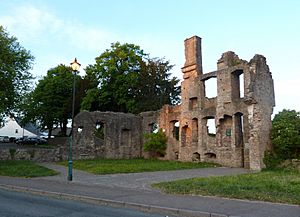The Procurator's House, Magor facts for kids
Quick facts for kids The Procurator's House, Magor |
|
|---|---|
 |
|
| Type | Ruin |
| Location | Magor, Monmouthshire |
| Official name: The Procurator's House, also known as Magor Mansion | |
| Reference no. | MM180 |
|
Listed Building – Grade II*
|
|
| Designated | 31 May 1995 |
| Reference no. | 16064 |
| Lua error in Module:Location_map at line 420: attempt to index field 'wikibase' (a nil value). | |
The Procurator's House is a large, ruined old mansion in Magor, Monmouthshire. It stands right next to St Mary's Church in the middle of the village. This building is also known as Magor Mansion or The Church House. It was built around the 1500s.
Even though it has a church-related name, it's unlikely a "Procurator" actually lived in this specific house. A Procurator was a church official who collected money for the church, like tithes (a kind of tax). In the Middle Ages, the Church of St Mary's was controlled by a powerful abbey in Italy called Anagni. It's possible an earlier building on this same spot was home to their procurator. However, the current building was built later. It was constructed when Tintern Abbey controlled St Mary's Church. A document from 1585 calls it "the mansion house belonging to the vicarage of Magor." This explains why it's also called Magor Mansion and The Church House. This site is one of only two known places in Britain where such a procurator's house might have stood.
A Look Back in Time
In the 1200s, the Abbey of Anagni in Italy became very rich and powerful. Four Popes came from this abbey in just 100 years! In 1238, during the time of Pope Gregory IX, St Mary's Church in Magor and its lands came under the abbey's control. This happened because Gilbert Marshal, 4th Earl of Pembroke, who was Lord of Chepstow, gave the church to the abbey.
The Abbey of Anagni managed the church until 1385. During that time, it's possible a house was built for the abbey's procurator on the same spot where the ruins stand today.
Later, in 1385, the church and its tithes (church taxes) were taken over by the Cistercian monks from Tintern Abbey. The current building was constructed sometime in the early to mid-1500s. It was mentioned in a document from 1585 as a "mansion belonging to the vicarage of Magor."
What Does It Look Like?
The original Procurator's House was built using Old Red Sandstone. It had a core made of rubble, and its decorative parts were made from Triassic sandstone. The building had two floors, with a cellar underneath. The main floor was divided into three rooms, and each room had its own fireplace. This layout was very common for priests' houses in the late medieval period. The house was mostly rectangular, with two parts sticking out from the main building.
The site of the Procurator's House is quite rare. It's one of only two such houses known in Britain. The other one is Chesterton Tower, which is near Cambridge.
There's a plaque at the ruins that says they are from the 1300s, not the 1500s. This idea is also mentioned on the Magor with Undy Community Council website. However, this information is disagreed with by official groups like Cadw (the Welsh government's historic environment service) and the Royal Commission on the Ancient and Historical Monuments of Wales. John Newman, who wrote a famous guide called The Buildings of Wales: Gwent/Monmouthshire, also believes the house is from the 1500s.
The ruins are considered a Scheduled Monument. They are also a Grade II* listed building. This means they are very important because of their "important architectural and historic interest."

